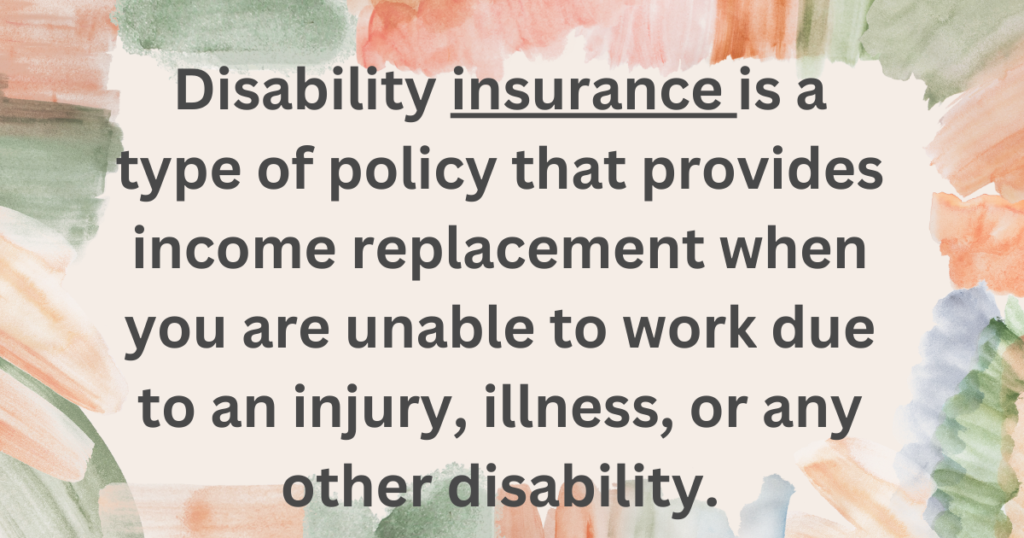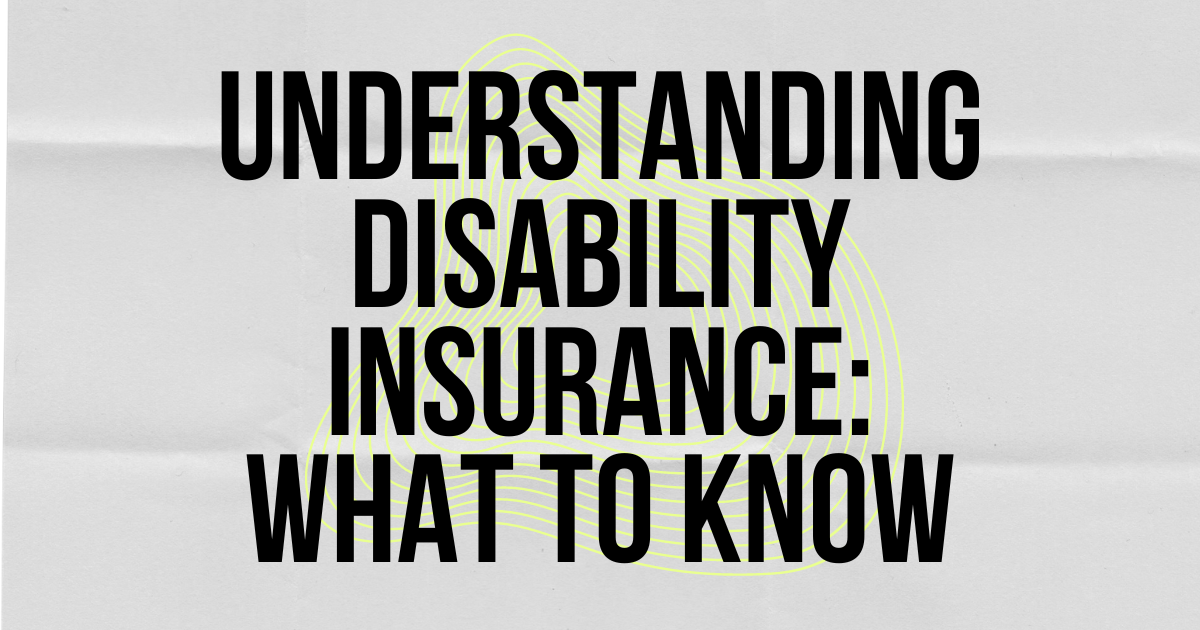Disability insurance is an essential, yet often overlooked, form of financial protection that can be a lifeline if you become unable to work due to illness or injury. While many people associate “disability” with permanent conditions, disability insurance covers a wide range of situations, from temporary impairments to long-term incapacitation. This type of insurance helps replace a portion of your income when you can no longer earn wages due to a disabling condition, ensuring that your financial obligations are still met.
In this comprehensive guide, we will explore what disability insurance is, how it works, its various types, who needs it, how to choose a policy, and common misconceptions about this type of coverage. By the end, you’ll have a solid understanding of how disability insurance can fit into your financial safety net.
Table of Contents
- What is Disability Insurance?
- Types of Disability Insurance
- How Disability Insurance Works
- Short-Term vs. Long-Term Disability Insurance
- Key Features of Disability Insurance Policies
- Who Needs Disability Insurance?
- How to Choose a Disability Insurance Policy
- Disability Insurance Through Employers vs. Private Policies
- Conclusion
1. What is Disability Insurance?

Disability insurance is a type of policy that provides income replacement when you are unable to work due to an injury, illness, or any other disability. It acts as a financial buffer, allowing you to cover living expenses such as rent, mortgage payments, utilities, and groceries while you’re unable to earn an income.
The amount you receive from disability insurance is usually a percentage of your normal income—typically between 60% and 80%—depending on the policy. This income replacement is crucial, especially if you’re the primary breadwinner or if your family relies heavily on your salary for essential expenses.
2. Types of Disability Insurance
There are two main types of disability insurance: short-term and long-term disability insurance. In addition, you may encounter other specific variations such as group disability insurance (offered by employers), supplemental policies, and government-provided disability benefits (such as Social Security Disability Insurance in the U.S.). Here’s an overview of each type:
- Short-term disability insurance (STD): This policy provides income replacement for a short period, typically up to six months, depending on the policy. It is often offered through employers as part of their benefits package.
- Long-term disability insurance (LTD): LTD covers more severe or long-lasting disabilities, usually kicking in after short-term benefits have been exhausted. Long-term policies can last for several years, until retirement, or for the duration of the disability.
- Group disability insurance: Often offered by employers, this form of insurance provides coverage for employees as part of a benefits package. Group policies tend to be more affordable but may offer limited benefits compared to individual policies.
- Individual disability insurance: A private policy purchased by the individual, typically offering more flexibility and higher coverage limits compared to group policies.
- Social Security Disability Insurance (SSDI): A government-provided benefit available to individuals who meet specific criteria, such as having a qualifying disability and sufficient work history.
3. How Disability Insurance Works
When you purchase a disability insurance policy, you’re essentially paying premiums for the promise of income replacement should you become unable to work due to a disabling event. Here’s how the process works:
- Paying premiums: As with other forms of insurance, you’ll pay a regular premium to maintain coverage. Premium amounts are influenced by factors like age, occupation, health, and the policy’s features (e.g., coverage amount, waiting period, and benefit period).
- Triggering a claim: If you become disabled, you will need to file a claim with your insurance company. This involves providing medical proof of your disability and documentation of your income.
- Waiting period: Most disability policies have an elimination period (waiting period) before benefits begin. The waiting period can range from a few days for short-term policies to 90 or 180 days for long-term policies.
- Receiving benefits: Once your claim is approved and the waiting period has passed, you will begin receiving benefits in the form of regular payments, which are often monthly. These payments will continue until you recover or the maximum benefit period (outlined in your policy) is reached.
- Benefit amount: The amount you receive will depend on the coverage you selected. Many policies cover 60% to 80% of your pre-disability income, though some high-income earners may opt for supplemental coverage to increase this percentage.
4. Short-Term vs. Long-Term Disability Insurance
Understanding the distinction between short-term and long-term disability insurance is essential to choosing the right policy for your needs.
Short-Term Disability Insurance
- Coverage period: Typically lasts for a few weeks to six months.
- Waiting period: Benefits may begin within a few days to two weeks after the disability starts.
- Common uses: Recovery from surgery, pregnancy complications, temporary injuries like fractures or sprains.
- Benefit amount: Typically 60% to 80% of your salary.
Long-Term Disability Insurance
- Coverage period: Can last several years, until retirement, or for the duration of the disability.
- Waiting period: Often 90 to 180 days before benefits begin.
- Common uses: Serious injuries, chronic illnesses, mental health disorders that prevent long-term employment.
- Benefit amount: Typically 50% to 70% of pre-disability income, depending on the policy.
5. Key Features of Disability Insurance Policies
When considering a disability insurance policy, pay attention to these key features that can influence your coverage:
- Definition of disability: Policies may define disability differently. Some provide benefits if you are unable to work in your current occupation (own-occupation), while others only pay if you’re unable to perform any occupation (any-occupation).
- Benefit period: This is how long the insurance will pay benefits once you become disabled. Short-term policies usually cover up to six months, while long-term policies can cover several years or until retirement.
- Elimination (waiting) period: This is the period between when the disability occurs and when benefits begin. The longer the waiting period, the lower the premiums, but the more you’ll need to cover out-of-pocket until benefits kick in.
- Residual benefits: Some policies provide partial benefits if you’re still able to work but your income is reduced due to a disability. This is especially helpful for those in jobs that require physical or mental acuity.
- Non-cancelable vs. guaranteed renewable: A non-cancelable policy ensures that your premiums won’t increase and the policy won’t be canceled as long as you pay your premiums on time. A guaranteed renewable policy, while ensuring the insurer can’t cancel your policy, may come with potential premium increases.
6. Who Needs Disability Insurance?
Disability insurance is essential for anyone who relies on their income to support themselves or their family. While many people assume that disability only affects older individuals or those in physically demanding jobs, the reality is that accidents and illnesses can strike anyone at any time.
Here’s who should strongly consider disability insurance:
- Primary earners: If you are the primary source of income in your household, a disability could severely impact your family’s financial stability.
- Self-employed individuals: Entrepreneurs and self-employed individuals often lack the safety net of employer-provided benefits and would need private disability insurance to protect their income.
- Those with dependents: If you have children or other dependents who rely on your income, disability insurance ensures that they’re taken care of in case you become unable to work.
- High-risk professions: People in physically demanding or high-risk jobs (e.g., construction workers, nurses, athletes) are more likely to suffer from disabling injuries, making disability insurance crucial.
Even if you work in an office or have a seemingly low-risk job, you’re not immune to illnesses or accidents that could disrupt your ability to work.
7. How to Choose a Disability Insurance Policy
Choosing the right disability insurance policy involves balancing several factors to meet your needs and budget. Here’s how to get started:
- Assess your income needs: Determine how much income you would need to replace in the event of a disability. Consider your current salary, monthly expenses, and any savings you could use during the waiting period.
- Choose the right coverage amount: Most policies replace 60% to 80% of your income, but consider whether you need additional coverage to maintain your standard of living.
- Decide on the benefit period: Longer benefit periods provide more comprehensive protection but come with higher premiums. Think about how long you would need coverage based on your savings and retirement plans.
- Understand the elimination period: Choose a waiting period that makes sense for your financial situation. If you have an emergency fund, you may opt for a longer elimination period to reduce premiums.
- Look for portability: If you expect to change jobs or careers frequently, consider an individual policy that you can keep even if you leave your current employer.
- Compare policies and providers: Shop around and compare quotes from multiple providers. Look for companies with a strong reputation for paying claims and good customer service.
8. Disability Insurance Through Employers vs. Private Policies
Many people have access to group disability insurance through their employers, but there are important differences between employer-provided and individual policies.
Employer-Provided Disability Insurance:
- Cost: Often more affordable since employers cover part or all of the premiums.
- Coverage limits: Typically, these policies offer basic coverage with lower benefit amounts and shorter benefit periods.
- Portability: Group coverage typically ends when you leave your job, meaning you may lose your disability insurance if you change employers or become unemployed. Some policies may offer the option to convert to an individual policy, but this can come with higher premiums or reduced coverage.
Private Disability Insurance: - Cost: Private policies tend to be more expensive but offer more customization and higher benefit amounts.
- Coverage limits: You can tailor the policy to your specific needs, including selecting longer benefit periods, higher coverage amounts, and shorter waiting periods.
- Portability: Individual policies are fully portable, meaning you can keep the coverage even if you change jobs or careers, ensuring continued protection.
- Customizability: Private policies often come with additional features and riders, such as residual benefits, future increase options, and cost-of-living adjustments.If you rely heavily on employer-provided disability insurance, it’s important to review the policy carefully. Often, the coverage provided by your employer may not be sufficient to replace your income adequately in the event of a disability. Many individuals opt to purchase supplemental private disability insurance to close the gap and ensure comprehensive coverage.
Conclusion
Disability insurance is a critical part of a well-rounded financial protection plan, yet it’s often misunderstood or overlooked. Whether you’re young and healthy or working in a physically demanding job, having a disability insurance policy can provide peace of mind by ensuring that your income is protected in the event of a disabling illness or injury.
When considering disability insurance, it’s important to evaluate your personal financial situation, income needs, and existing coverage. Understanding the key features of disability insurance policies, the different types available, and the common exclusions will help you make an informed decision about which policy is right for you.
Ultimately, disability insurance is about more than just protecting your paycheck—it’s about safeguarding your future and the financial well-being of your loved ones. By securing a disability insurance policy, you can ensure that even in the face of unexpected challenges, you’ll have the financial support you need to maintain your quality of life.
